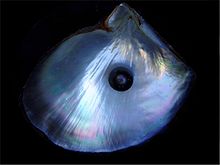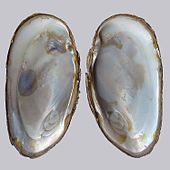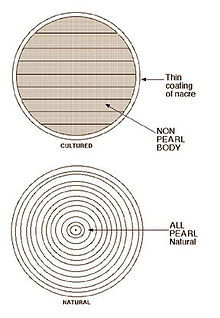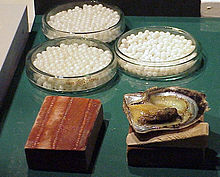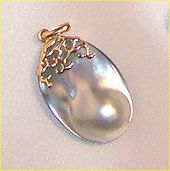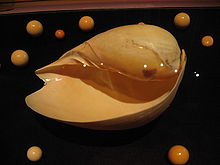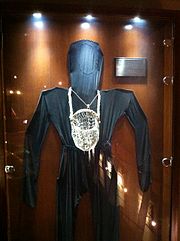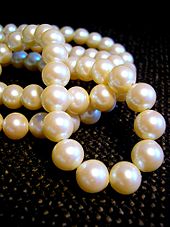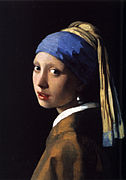- Pearl
-
For other uses, see Pearl (disambiguation).
Pearl 
PearlsGeneral Category Mineral Chemical formula CaCO3 Identification Color white, pink, silver-, cream-, golden-colored, green, blue, black, yellow, rainbow
2369Cleavage none Mohs scale hardness 2.5-4.5 Streak white Specific gravity 2.60-2.85 Dispersion none Ultraviolet fluorescence weak, cannot be evaluated. Genuine black p .: Red to reddish River-p.: Strong: pale green A pearl is a hard object produced within the soft tissue (specifically the mantle) of a living shelled mollusk. Just like the shell of a mollusk, a pearl is made up of calcium carbonate in minute crystalline form, which has been deposited in concentric layers. The ideal pearl is perfectly round and smooth, but many other shapes of pearls (baroque pearls) occur. The finest quality natural pearls have been highly valued as gemstones and objects of beauty for many centuries, and because of this, the word pearl has become a metaphor for something very rare, fine, admirable, and valuable.
The most valuable pearls occur spontaneously in the wild, but they are extremely rare. These wild pearls are referred to as natural pearls. Cultured or farmed pearls from pearl oysters and freshwater mussels make up the majority of those that are currently sold. Imitation or fake pearls are also widely sold in inexpensive jewelry, but the quality of their iridescence is usually very poor, and generally speaking, artificial pearls are easily distinguished from genuine pearls. Pearls have been harvested and cultivated primarily for use in jewelry, but in the past they were also stitched onto lavish clothing. Pearls have also been crushed and used in cosmetics, medicines, and in paint formulations.
Whether wild or cultured, gem quality pearls are almost always nacreous and iridescent, as is the interior of the shell that produces them. However, almost all species of shelled mollusks are capable of producing pearls (formerly referred to as "calcareous concretions" by some sources) of lesser shine or less spherical shape. Although these may also be legitimately referred to as "pearls" by gemological labs and also under U.S. Federal Trade Commission rules,[1] and are formed in the same way, most of them have no value, except as curiosities.
Evolutionary significance
Pearls are commonly viewed by scientists as a by-product of an adaptive immune system-like function.[2]
Etymology
The English word pearl comes from the French perle, originally from the Latin diminutive of perna leg, ham, leg-of-mutton shaped bivalve.[3]
Definition
Almost any shelled mollusk can, by natural processes, produce some kind of "pearl" when an irritating microscopic object becomes trapped within the mollusk's mantle folds, but the great majority of these "pearls" are not valued as gemstones. Nacreous pearls, the best-known and most commercially-significant pearls, are primarily produced by two groups of molluscan bivalves or clams. A nacreous pearl is made from layers of nacre, by the same living process as is used in the secretion of the mother of pearl which lines the shell.
A "natural pearl" or "wild pearl" is one that forms without any human intervention at all, in the wild, and is very rare. Many hundreds of pearl oysters or pearl mussels have to be gathered and opened, and thus killed, in order to find even one wild pearl, and for many centuries that was the only way pearls were obtained. This was the main reason why pearls fetched such extraordinary prices in the past. A cultured pearl is formed in a pearl farm, using human intervention as well as natural processes.
One family of nacreous pearl bivalves – the pearl oyster – lives in the sea, while the other – a very different group of bivalves – lives in freshwater; these are the river mussels such as the freshwater pearl mussel. Saltwater pearls can grow in several species of marine pearl oysters in the family Pteriidae. Freshwater pearls grow within certain (but by no means all) species of freshwater mussels in the order Unionida, the families Unionidae and Margaritiferidae.
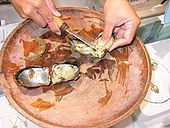 A pearl being extracted from an akoya pearl oyster.
A pearl being extracted from an akoya pearl oyster.
Physical properties
The unique luster of pearls depends upon the reflection, refraction, and diffraction of light from the translucent layers. The thinner and more numerous the layers in the pearl, the finer the luster. The iridescence that pearls display is caused by the overlapping of successive layers, which breaks up light falling on the surface. In addition, pearls (especially cultured freshwater pearls) can be dyed yellow, green, blue, brown, pink, purple, or black. The very best pearls have a metallic mirror-like lustre.
Freshwater and saltwater pearls
Freshwater and saltwater pearls may sometimes look quite similar, but they come from different sources.
Freshwater pearls form in various species of freshwater mussels, family Unionidae, which live in lakes, rivers, ponds and other bodies of fresh water. These freshwater pearl mussels occur not only in hotter climates, but also in colder more temperate areas such as Scotland (where they are totally protected under law). However, most freshwater cultured pearls sold today come from China.
Saltwater pearls grow within pearl oysters, family Pteriidae, which live in oceans. Saltwater pearl oysters are usually cultivated in protected lagoons or volcanic atolls.
Creation of a pearl
The difference between wild and cultured pearls focuses on whether the pearl was created spontaneously by nature – without human intervention – or with human aid. Pearls are formed inside the shell of certain mollusks as a defense mechanism against a potentially threatening irritant such as a parasite inside its shell, or an attack from outside, injuring the mantle tissue. The mollusk creates a pearl sac to seal off the irritation.
The mantle of the mollusk deposits layers of calcium carbonate (CaCO3) in the form of the mineral aragonite or a mixture of aragonite and calcite (polymorphs with the same chemical formula, but different crystal structures) held together by an organic horn-like compound called conchiolin. The combination of aragonite and conchiolin is called nacre, which makes up mother-of-pearl. The commonly held belief that a grain of sand acts as the irritant is in fact rarely the case. Typical stimuli include organic material, parasites, or even damage that displaces mantle tissue to another part of the mollusk's body. These small particles or organisms gain entry when the shell valves are open for feeding or respiration. In cultured pearls, the irritant is typically an introduced piece of the mantle epithelium, together or without a spherical bead (beaded or beadless cultured pearls).[4][5]
Natural pearls
Natural pearls are nearly 100% calcium carbonate and conchiolin. It is thought that natural pearls form under a set of accidental conditions when a microscopic intruder or parasite enters a bivalve mollusk, and settles inside the shell. The mollusk, being irritated by the intruder, forms a pearl sac of external mantle tissue cells and secretes the calcium carbonate and conchiolin to cover the irritant. This secretion process is repeated many times, thus producing a pearl. Natural pearls come in many shapes, with perfectly round ones being comparatively rare.
Typically, the build-up of a natural pearl consists of a brown central zone formed by columnar calcium carbonate (usually calcite, sometimes columnar aragonite) and a yellowish to white outer zone consisting of nacre (tabular aragonite). In a pearl cross-section such as the diagram, these two different materials can be seen. The presence of columnar calcium carbonate rich in organic material indicates juvenile mantle tissue that formed during the early stage of pearl development. Displaced living cells with a well-defined task may continue to perform their function in their new location, often resulting in a cyst. Such displacement may occur via an injury. The fragile rim of the shell is exposed and is prone to damage and injury. Crabs, other predators and parasites such as worm larvae may produce traumatic attacks and cause injuries in which some external mantle tissue cells are disconnected from their layer. Embedded in the conjunctive tissue of the mantle, these cells may survive and form a small pocket in which they continue to secrete their natural product: calcium carbonate. The pocket is called a pearl sack, and grows with time by cell division; in this way the pearl grows also. The juvenile mantle tissue cells, according to their stage of growth, produce columnar calcium carbonate, which is secreted from the inner surface of the pearl sack. With ongoing time the external mantle cells of the pearl sack proceed to the formation of tabular aragonite. When the transition to nacre secretion occurs, the brown pebble becomes covered with a nacreous coating. As this process progresses, the shell itself grows, and the pearl sack seems to travel into the shell. However, it actually stays in its original relative position within the mantle tissue. After a couple of years, a pearl will have formed and the shell might be found by a lucky pearl fisher.[6]
Cultured pearls
Main article: Cultured pearlCultured pearls are the response of the shell to a tissue implant. A tiny piece of mantle tissue from a donor shell is transplanted into a recipient shell. This graft will form a pearl sac and the tissue will precipitate calcium carbonate into this pocket. There are a number of options for producing cultured pearls: use freshwater or seawater shells, transplant the graft into the mantle or into the gonad, add a spherical bead or do it non-beaded. The majority of saltwater cultured pearls are grown with beads. The trade name of the cultured pearls are Akoya, white or golden South sea, and black Tahitian. The majority of beadless cultured pearls are mantle-grown in freshwater shells in China, known as freshwater cultured pearls.
Cultured pearls (beadless or beaded) and imitation pearls can be distinguished from natural pearls by X-ray examination. Nucleated cultured pearls are often 'pre-formed' as they tend to follow the shape of the implanted shell bead nucleus. Once the pre-formed beads are inserted into the oyster, it secretes a few layers of nacre around the outside surface of the implant before it is removed after six months or more.
When a cultured pearl with bead is X-rayed, it reveals a different structure to that of a natural pearl. A beaded cultured pearl shows a solid center with no concentric growth rings, whereas a natural pearl shows a series of concentric growth rings. A beadless cultured pearl (whether of freshwater or saltwater origin) may show growth rings, but also a complex central cavity, witness of the first precipitation of the young pearl sac.
Gemological identification
A well equipped gem testing laboratory is able to distinguish natural pearls from cultured pearls by using a gemological x-ray in order to examine the center of a pearl. With an x-ray it is possible to see the growth rings of the pearl, where the layers of calcium carbonate are separated by thin layers of conchiolin. The differentiation of natural pearls from non-beaded cultured pearls can be very difficult without the use of this x-ray technique.
Natural and cultured pearls can be distinguished from imitation pearls using a microscope. Another method of testing for imitations is to rub two pearls against each other. Imitation pearls are completely smooth, but natural and cultured pearls are composed of nacre platelets, making both feel slightly gritty.
Value of a natural pearl
Quality natural pearls are very rare jewels. The actual value of a natural pearl is determined in the same way as it would be for other "precious" gems. The valuation factors include size, shape, color, quality of surface, orient and luster.
Single, natural pearls are often sold as a collector's item, or set as centerpieces in unique jewelry. Very few matched strands of natural pearls exist, and those that do often sell for hundreds of thousands of dollars. (In 1917, jeweler Pierre Cartier purchased the Fifth Avenue mansion that is now the New York Cartier store in exchange for a matched, double strand of natural pearls that he had been collecting for years; valued at the time at $1 million USD.)[7]
The Great Depression effectively slashed the value of the natural pearl, but there is no doubt that it had been some time coming. The introduction and advance of the cultured pearl hit the pearl industry hard; it had pearl dealers publicly disputing over the authenticity of these new cultured pearls, and left many consumers uneasy and confused about the much lower prices. Essentially, it damaged the image of both natural and cultured pearls alike. By the 1950s, an era of every woman being able to own her own pearl necklace had begun, and natural pearls were reduced to a small, exclusive niche in the pearl industry.
Origin of a natural pearl
Previously, natural pearls were found in many parts of the world. Present day natural pearling is confined mostly to seas off Bahrain. Australia also has one of the world's last remaining fleets of pearl diving ships. Australian pearl divers dive for south sea pearl oysters to be used in the cultured south sea pearl industry. The catch of pearl oysters is similar to the numbers of oysters taken during the natural pearl days. Hence significant numbers of natural pearls are still found in the Australian Indian Ocean waters from wild oysters. X-Ray examination is required to positively verify natural pearls found today.
Types of cultured pearls
Keshi pearls, although they often occur by chance, are not considered natural pearls. They are a byproduct of the culturing process, and hence do not happen without human intervention. These pearls are quite small: typically a few millimeters in size. Keshi pearls are produced by many different types of marine mollusks and freshwater mussels in China.[8] Today many "keshi" pearls are actually intentional, with post-harvest shells returned to the water to regenerate a pearl in the existing pearl sac.
The Tahitian pearl, frequently referred to as Black Tahitian Pearls, are highly valued because of their rarity; the culturing process for them dictates a smaller volume output and they can never be mass produced because, in common with most sea pearls, the oyster can only be nucleated with one pearl at a time, while freshwater mussels are capable of multiple pearl implants. Before the days of cultured pearls, black pearls were rare and highly valued for the simple reason that white pearl oysters rarely produced naturally black pearls, and black pearl oysters rarely produced any natural pearls at all.

 Mary, Queen of Scots by an unknown artist after François Clouet (c. 1559)The Queen is shown wearing her rope of famous black pearls.
Mary, Queen of Scots by an unknown artist after François Clouet (c. 1559)The Queen is shown wearing her rope of famous black pearls.
London, Victoria and Albert MuseumSince the development of pearl culture technology, the black pearl oyster found in Tahiti and many other Pacific Island areas has been extensively used for producing cultured pearls. The rarity of the black cultured pearl is now a "comparative" issue. The black cultured pearl is rare when compared to Chinese freshwater cultured pearls, and Japanese and Chinese akoya cultured pearls, and is more valuable than these pearls. However, it is more abundant than the South Sea pearl, which is more valuable than the black cultured pearl. This is simply because the black pearl oyster Pinctada margaritifera is far more abundant than the elusive, rare, and larger south sea pearl oyster Pinctada maxima, which cannot be found in lagoons, but which must be dived for in a rare number of deep ocean habitats or grown in hatcheries. In fact Black pearls are very rarely black: they are usually shades of green,purple, aubergine, blue, grey, silver or peacock (a mix of several shades, like a peacock's feather) Black cultured pearls from the black pearl oyster – Pinctada margaritifera – are not South Sea pearls, although they are often mistakenly described as black South Sea pearls. In the absence of an official definition for the pearl from the black oyster, these pearls are usually referred to as "black Tahitian pearls".
The correct definition of a South Sea pearl – as described by CIBJO and GIA – is a pearl produced by the Pinctada maxima pearl oyster. South Sea pearls are the color of their host Pinctada maxima oyster – and can be white, silver, pink, gold, cream, and any combination of these basic colors, including overtones of the various colors of the rainbow displayed in the pearl nacre of the oyster shell itself.
South Sea Pearls are produced in various parts of the world. White ones tend to come from the Broome area of Australia while golden ones are from the Philippines. Pearls are also produced in the Cook Islands and one farm in the Sea of Cortez, Mexico, from Concha Nácar the rainbow lipped oyster; these pearls fluoresce red under ultraviolet light.
Pearls from other species
Biologically speaking, under the right set of circumstances, almost any shelled mollusk can produce some kind of pearl, however, most of these molluscan pearls have no luster or iridescence. The great majority of mollusk species produce pearls which are not attractive, and are sometimes not even very durable, such that they usually have no value at all, except perhaps to a scientist, a collector, or as a curiosity. These objects used to be referred to as "calcareous concretions" by some gemologists, even though a malacologist would still consider them to be pearls. Valueless pearls of this type are sometimes found in edible mussels, edible oysters, escargot snails, and so on. The GIA and CIBJO now simply use the term 'pearl' (or, where appropriate, the more descriptive term 'non-nacreous pearl') when referring to such items[9][10] and, under Federal Trade Commission rules, various mollusc pearls may be referred to as 'pearls', without qualification.[1]
 Pearl of Allah, the largest known pearl came from a giant clam
Pearl of Allah, the largest known pearl came from a giant clam
A few species produce pearls that can be of interest as gemstones. These species include the bailer shell Melo, the giant clam Tridacna, various scallop species, Pen shells Pinna, and the Haliotis iris species of abalone. Abalone, or Pāua are Mabe pearls unique to New Zealand waters and are commonly referred to as 'Blue Pearls'. They are admired for their incredible luster and naturally bright vibrant colors that are often compared to Opal. Another example is the conch pearl (sometimes referred to simply as the 'pink pearl'), which is found very rarely growing between the mantle and the shell of the queen conch or pink conch, Strombus gigas, a large sea snail or marine gastropod from the Caribbean Sea. These pearls, which are often pink in color, are a by-product of the conch fishing industry, and the best of them display a shimmering optical effect related to chatoyance known as 'flame structure'.
Somewhat similar gastropod pearls, this time more orange in hue, are (again very rarely) found in the horse conch Pleuroploca gigantea.
The largest pearl known was found in the Philippines in 1934 and is known as the Pearl of Allah or Pearl of Lao Tzu. It is a naturally-occurring, non-nacreous, calcareous concretion (pearl) from a giant clam. Because it did not grow in a pearl oyster it is not pearly; instead the surface is glossy like porcelain. Other pearls from giant clams are known to exist, but this is a particularly large one, weighing 14 lb (6.4 kg).
History of pearl hunting and pearl farming
Pearl hunting
Main article: Pearl huntingFor thousands of years, most seawater pearls were retrieved by divers working in the Indian Ocean, in areas like the Persian Gulf, the Red Sea[citation needed], and in the Gulf of Mannar.[11] Starting in the Han Dynasty (206 BC–220 AD), the Chinese hunted extensively for seawater pearls in the South China Sea.[citation needed] In the 14th-century Arabian Sea, the traveller Ibn Battuta provided the earliest known description of pearl diving by means of attaching a cord to the diver's waist.[12]
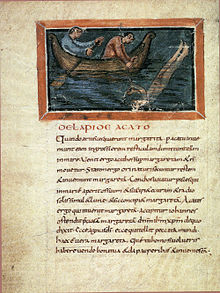 Catching of pearls, Bern Physiologus (IX century)
Catching of pearls, Bern Physiologus (IX century)
When Spanish conquistadors arrived in the Western Hemisphere, they discovered that around the islands of Cubagua and Margarita, some 200 km north of the Venezuelan coast, was an extensive pearl bed (a bed of pearl oysters). One discovered and named pearl, La Peregrina pearl, was offered to the Spanish queen.[citation needed] According to Garcilasso de la Vega, who says that he saw La Peregrina at Seville in 1507, (Garcilasso, "Historie des Incas, Rois du Perou," Amsterdam, 1704, Vol. II, P. 352.) this was found at Panama in 1560 by a slave worker who was rewarded with his liberty, and his owner with the office of alcalde of Panama.
Margarita pearls are extremely difficult to find today and are known for their unique yellowish color. The most famous Margarita necklace that any one can see today is the one that then Venezuelan President Romulo Betancourt gave to Jacqueline Kennedy when she and her husband, President John F. Kennedy paid an official visit to Venezuela.[citation needed]
Before the beginning of the 20th century, pearl hunting was the most common way of harvesting pearls. Divers manually pulled oysters from ocean floors and river bottoms and checked them individually for pearls. Not all mussels and oysters produce pearls. In a haul of three tons, only three or four oysters will produce perfect pearls.[citation needed]
Development of pearl farming
Today, the cultured pearls on the market can be divided into two categories. The first category covers the beaded cultured pearls, including Akoya, South Sea and Tahiti. These pearls are gonad grown, and usually one pearl is grown at a time. This limits the number of pearls at a harvest period. The pearls are usually harvested after one year for akoya, 2–4 years for Tahitian and South Sea, and 2–7 years for freshwater. This perliculture process was first developed by the British biologist William Saville-Kent who passed the information along to Tatsuhei Mise and Tokichi Nishikawa from Japan. The second category includes the non-beaded freshwater cultured pearls, like the Biwa or Chinese pearls. As they grow in the mantle, where on each wing up to 25 grafts can be implanted, these pearls are much more frequent and saturate the market completely. An impressive improvement in quality has taken place in the last ten years when the former rice grain-shaped pebbles are compared with the near round pearls of today. In the last two years large near perfect round bead nucleated pearls up to 15mm in diameter have been produced with metallic lustre.
The nucleus bead in a beaded cultured pearl is generally a polished sphere made from freshwater mussel shell. Along with a small piece of mantle tissue from another mollusk (donor shell) to serve as a catalyst for the pearl sac, it is surgically implanted into the gonad (reproductive organ) of a saltwater mollusk. In freshwater perliculture, only the piece of tissue is used in most cases, and is inserted into the fleshy mantle of the host mussel. South Sea and Tahitian pearl oysters, also known as Pinctada maxima and Pinctada margaritifera, which survive the subsequent surgery to remove the finished pearl, are often implanted with a new, larger beads as part of the same procedure and then returned to the water for another 2–3 years of growth.
Despite the common misperception, Mikimoto did not discover the process of pearl culture. The accepted process of pearl culture was developed by the British Biologist William Saville-Kent in Australia and brought to Japan by Tokichi Nishikawa and Tatsuhei Mise. Nishikawa was granted the patent in 1916, and married the daughter of Mikimoto. Mikimoto was able to use Nishikawa's technology. After the patent was granted in 1916, the technology was immediately commercially applied to akoya pearl oysters in Japan in 1916. Mise's brother was the first to produce a commercial crop of pearls in the akoya oyster. Mitsubishi's Baron Iwasaki immediately applied the technology to the south sea pearl oyster in 1917 in the Philippines, and later in Buton, and Palau. Mitsubishi was the first to produce a cultured south sea pearl – although it was not until 1928 that the first small commercial crop of pearls was successfully produced.
The original Japanese cultured pearls, known as akoya pearls, are produced by a species of small pearl oyster, Pinctada fucata martensii, which is no bigger than 6 to 8 cm in size, hence akoya pearls larger than 10 mm in diameter are extremely rare and highly priced. Today, a hybrid mollusk is used in both Japan and China in the production of akoya pearls.
Recent pearl production
In 2010, China overtook Japan in akoya pearl production.[13] Japan has all but ceased its production of akoya pearls smaller than 8 mm. [13] Japan maintains its status as a pearl processing center, however, and imports the majority of Chinese akoya pearl production. These pearls are then processed (often simply matched and sorted), relabeled as product of Japan, and exported.[14]
In the past couple of decades, cultured pearls have been produced using larger oysters in the south Pacific and Indian Ocean. The largest pearl oyster is the Pinctada maxima, which is roughly the size of a dinner plate. South Sea pearls are characterized by their large size and warm luster. Sizes up to 14 mm in diameter are not uncommon. South Sea pearls are primarily produced in Australia, Indonesia and the Philippines.
Mitsubishi commenced pearl culture with the south sea pearl oyster in 1916, as soon as the technology patent was commercialized. By 1931 this project was showing signs of success, but was upset by the death of Tatsuhei Mise. Although the project was recommenced after Tatsuhei's death, the project was discontinued at the beginning of WWII before significant productions of pearls were achieved.
After WWII, new south sea pearl projects were commenced in the early 1950s in Burma and Kuri Bay and Port Essington in Australia. Japanese companies were involved in all projects using technicians from the original Mitsubishi south sea pre-war projects.
Freshwater pearl farming
In 1914, pearl farmers began growing cultured freshwater pearls using the pearl mussels native to Lake Biwa. This lake, the largest and most ancient in Japan, lies near the city of Kyoto. The extensive and successful use of the Biwa Pearl Mussel is reflected in the name Biwa pearls, a phrase which was at one time nearly synonymous with freshwater pearls in general. Since the time of peak production in 1971, when Biwa pearl farmers produced six tons of cultured pearls, pollution has caused the virtual extinction of the industry. Japanese pearl farmers recently[when?] cultured a hybrid pearl mussel – a cross between Biwa Pearl Mussels and a closely related species from China, Hyriopsis cumingi, in Lake Kasumigaura. This industry has also nearly ceased production, due to pollution.
Japanese pearl producers also invested in producing cultured pearls with freshwater mussels in the region of Shanghai, China. China has since become the world's largest producer of freshwater pearls, producing more than 1,500 metric tons per year (in addition to metric measurements, Japanese units of measurement such as the kan and momme are sometimes encountered in the pearl industry).
Led by pearl pioneer John Latendresse and his wife Chessy, the United States began farming cultured freshwater pearls in the mid 1960s. National Geographic magazine introduced the American cultured pearl as a commercial product in their August 1985 issue. The Tennessee pearl farm has emerged as a tourist destination in recent years, but commercial production of freshwater pearls has ceased.
Momme Weight
For many cultured pearl dealers and wholesalers, the preferred weight measure used for loose pearls and pearl strands is momme. Momme is a weight measure used by the Japanese for centuries. Today, momme weight is still the standard unit of measure used by most pearl dealers to communicate with pearl producers and wholesalers. One momme corresponds to 1/1000 kan. Reluctant to give up tradition, in 1891, the Japanese government formalized the kan measure as being exactly 1 kan = 3.75 kilograms or 8.28 pounds. Hence, 1 momme = 3.75 grams or 3750 milligrams.
In the United States, during the 19th and 20th centuries, through trade with Japan in silk cloth the momme became a unit indicating the quality of silk cloth.
Though millimeter size range is typically the first factor in determining a cultured pearl necklace's value, the momme weight of pearl necklace will allow the buyer to quickly determine if the necklace is properly proportioned. This is especially true when comparing the larger south sea and Tahitian pearl necklaces.
Pearls in jewelry
The value of the pearls in jewelry is determined by a combination of the luster, color, size, lack of surface flaw and symmetry that are appropriate for the type of pearl under consideration. Among those attributes, luster is the most important differentiator of pearl quality according to jewelers.
All factors being equal, however, the larger the pearl the more valuable it is. Large, perfectly round pearls are rare and highly valued. Teardrop-shaped pearls are often used in pendants.
Shapes
-
Queen Barbara Radziwiłł in coronation robes and a wimple embroided with pearls.
-
Girl with a Pearl Earring by Johannes Vermeer, c. 1665.
-
Portrait of Marie Antoinette, Queen of France wearing a pearl necklace and earrings.
Pearls come in eight basic shapes: round, semi-round, button, drop, pear, oval, baroque, and circled. Perfectly round pearls are the rarest and most valuable shape. Semi-rounds are also used in necklaces or in pieces where the shape of the pearl can be disguised to look like it is a perfectly round pearl. Button pearls are like a slightly flattened round pearl and can also make a necklace, but are more often used in single pendants or earrings where the back half of the pearl is covered, making it look like a larger, rounder pearl.
 Portrait of Empress Maria Fiodorovna in a Head-Dress Decorated with Pearls by Ivan Kramskoi (1880s)
Portrait of Empress Maria Fiodorovna in a Head-Dress Decorated with Pearls by Ivan Kramskoi (1880s)
Saint Petersburg, Hermitage MuseumDrop and pear shaped pearls are sometimes referred to as teardrop pearls and are most often seen in earrings, pendants, or as a center pearl in a necklace. Baroque pearls have a different appeal; they are often highly irregular with unique and interesting shapes. They are also commonly seen in necklaces. Circled pearls are characterized by concentric ridges, or rings, around the body of the pearl.
In general, cultured pearls are less valuable than natural pearls, whereas imitation pearls almost have no value. One way that jewelers can determine whether a pearl is cultured or natural is to have a gem lab perform an x-ray of the pearl. If the x-ray reveals a nucleus, the pearl is likely a bead-nucleated saltwater pearl. If no nucleus is present, but irregular and small dark inner spots indicating a cavity are visible, combined with concentric rings of organic substance, the pearl is likely a cultured freshwater. Cultured freshwater pearls can often be confused for natural pearls which present as homogeneous pictures which continuously darken toward the surface of the pearl. Natural pearls will often show larger cavities where organic matter has dried out and decomposed.
Some imitation pearls are simply made of mother-of-pearl, coral or conch shell, while others are made from glass and are coated with a solution containing fish scales called essence d'Orient. Although imitation pearls look the part, they do not have the same weight or smoothness as real pearls, and their luster will also dim greatly.
Lengths of pearl necklaces
 Portrait of Caterina Sagredo Barbarigo by Rosalba Carriera, cir. 1740. The subject is wearing a single-strand pearl collar and pendant pearl earrings
Portrait of Caterina Sagredo Barbarigo by Rosalba Carriera, cir. 1740. The subject is wearing a single-strand pearl collar and pendant pearl earrings
 Queen of Italy, Margherita of Savoy, owned one of the most famous collections of natural pearls. She is wearing a multi-strand choker and a rope of pearls, possibly with matching bracelet and earrings
Queen of Italy, Margherita of Savoy, owned one of the most famous collections of natural pearls. She is wearing a multi-strand choker and a rope of pearls, possibly with matching bracelet and earrings
There is a special vocabulary used to describe the length of pearl necklaces. While most other necklaces are simply referred to by their physical measurement, pearl necklaces are named by how low they hang when worn around the neck. A collar, measuring 10 to 13 inches or 25 to 33 cm in length, sits directly against the throat and does not hang down the neck at all; collars are often made up of multiple strands of pearls. Pearl chokers, measuring 14 to 16 inches or 35 to 41 cm in length, nestle just at the base of the neck. A strand called a princess length, measuring 17 to 19 inches or 43 to 48 cm in length, comes down to or just below the collarbone. A matinee length, measuring 20 to 24 inches or 50 to 60 cm in length, falls just above the breasts. An opera length, measuring 28 to 35 inches or 70 to 90 cm in length, will be long enough to reach the breastbone or sternum of the wearer; and longer still, a pearl rope, measuring more than 45 inches or 115 cm in length, is any length that falls down farther than an opera.
Necklaces can also be classified as uniform, or graduated. In a uniform strand of pearls, all pearls are classified as the same size, but actually fall in a range. A uniform strand of akoya pearls, for example, will measure within 0.5 mm. So a strand will never be 7 mm, but will be 6.5–7 mm. Freshwater pearls, Tahitian pearls, and South Sea pearls all measure to a full millimeter when considered uniform.
A graduated strand of pearls most often has at least 3 mm of differentiation from the ends to the center of the necklace. Popularized in the United States during the 1950s by the GIs bringing strands of cultured akoya pearls home from Japan, a 3.5 momme, 3 mm to 7 mm graduated strand was much more affordable than a uniform strand because most of the pearls were small.
Colors of pearl jewelry
Earrings and necklaces can also be classified on the grade of the color of the pearl. While white, and more recently black, saltwater pearls are by far the most popular, other color tints can be found on pearls from the oceans. Pink, blue, champagne, green, black and even purple saltwater pearls can be encountered, but to collect enough of these rare colors to form a complete string of the same size and same shade can take years.
Religious references
Hindu scriptures
The Hindu tradition describes the sacred Nine Pearls which were first documented in the Garuda Purana, one of the books of the Hindu mythology. Ayurveda contains references to pearl powder as a stimulant of digestion and to treat mental ailments. According to Marco Polo, the kings of Malabar wore a necklace of 104 rubies and pearls which was given from one generation of kings to the next. The reason was that every king had to say 104 prayers every morning and every evening.[15] At least until the beginning of the 20th century it was a Hindu custom to present a completely new, undrilled pearl and pierce it during the wedding ceremony.[16]
The Pearl or Mukta in Sanskrit is also associated with many Hindu deities. The most famous being the Koustubha which Lord Vishnu wears on his chest. Apart from religious connotations, stories and folklore abound of pearls occurring in snakes, the Naaga Mani, and elephants, the Gaja Mukta.
Hebrew scriptures
According to Rebbenu Bachya, the word Yahalom in the verse Exodus 28:18 means "pearl" and was the stone on the Hoshen representing the tribe of Zebulun. This is generally disputed among scholars, particularly since the word in question in most manuscripts is actually Yasepheh - the word from which jasper derives; scholars think that refers to green jasper (the rarest and most prized form in early times) rather than red jasper (the most common form). Yahalom is usually translated by the Septuagint as an "onyx", but sometimes as "beryl" or as "jasper"; onyx only started being mined after the Septuagint was written, so the Septuagint's term "onyx" probably does not mean onyx – onyx is originally an Assyrian word meaning ring, and so could refer to anything used for making rings. Yahalom is similar to a Hebrew word meaning hit hard, so some people think that it means diamond. The variation in possibilities of meaning for this sixth stone in the Hoshen is reflected in different translations of the Bible – the King James Version translates the sixth stone as diamond, the New International Version translates it as emerald, and the Vulgate translates it as jaspis – meaning jasper. There is a wide range of views among traditional sources about which tribe the stone refers to.
New Testament scriptures
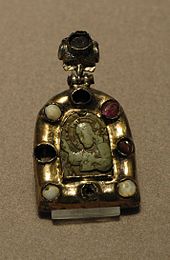 Religious pendant showing Christ blessing, framed with rubies and pearls, from the Byzantine empire, 12th or 13th century
Religious pendant showing Christ blessing, framed with rubies and pearls, from the Byzantine empire, 12th or 13th century
In a Christian New Testament parable, Jesus compared the Kingdom of Heaven to a "pearl of great price" in Matthew 13: 45-46. "Again, the kingdom of heaven is like unto a merchant man, seeking goodly (fine) pearls: Who, when he had found one pearl of great price, went and sold all that he had, and bought it."
The language of symbolism was in common use around the time of Jesus Christ; most people were familiar with the symbolic meanings. The circle is a symbol of God because it has no beginning and no end. The circle or pearl was considered to represent Love, Knowledge (the combination of equal amounts of Love and Knowledge is a symbol of Wisdom, the 2 circles intertwined (owl eyes) is symbolic of Wisdom. Some other pearls are Truth, and Faith.
The twelve gates of the New Jerusalem are reportedly each made of a single pearl in Revelation 21:21, that is, the Pearly Gates. "And the twelve gates were twelve pearls; every gate was of one pearl: and the streets of the city were pure gold, as if transparent glass."
Holy things are compared to pearls in Matthew 7:6. "Do not give dogs what is holy, and do not throw your pearls before pigs, lest they trample them underfoot and turn to attack you."
Pearls are also found in numerous references showing the wickedness and pride of a people, as in Revelation 18:16. "And saying, Alas, alas, that great city, that was clothed in fine linen, in purple and scarlet, and decked with gold, and precious stones, and pearls!"
Islamic scriptures
The Qur'an often mentions that dwellers of paradise will be adorned with pearls:
22:23 God will admit those who believe and work righteous deeds, to Gardens beneath which rivers flow: they shall be adorned therein with bracelets of gold and pearls; and their garments there will be of silk.
35:33 Gardens of Eternity will they enter: therein will they be adorned with bracelets of gold and pearls; and their garments there will be of silk.
The handsome young boys in paradise are similarly depicted:
52:24 Round about them will serve, [devoted] to them, youths [handsome] as pearls well-guarded.
Other scriptures
The metaphor of a pearl appears in the longer Hymn of the Pearl, a poem respected for its high literary quality, and use of layered theological metaphor, found within one of the texts of Gnosticism.
The Pearl of Great Price is a book of scripture in The Church of Jesus Christ of Latter-day Saints.
See also
- Ammolite – another organic gemstone formed primarily of fossil aragonite mollusk shells
- Broome, Western Australia, a pearling town
- Cave pearl
- Les pêcheurs de perles The Pearl Fishers an opera by Georges Bizet
- Amber
- Precious coral
References
- ^ a b "Guides for the Jewelry, Precious Metals, and Pewter Industries". Ftc.gov. 1996-05-30. http://www.ftc.gov/bcp/guides/jewel-gd.shtm. Retrieved 2010-07-17.
- ^ http://books.google.com/books?id=vO0fBTJKdBcC&q=pearl#v=snippet&q=pearl&f=false
- ^ Shorter Oxford English Dictionary (6th ed.), Oxford University Press, 2007, ISBN 978-0-19-920687-2
- ^ Neil H. Landman, et al (2001) Pearls: A Natural History, Harry Abrams, Inc., 232 pp., ISBN 0-8109-4495-2
- ^ "Pearl oyster farming and pearl culture". Fao.org. Archived from the original on 2008-03-20. http://web.archive.org/web/20080320144812/http://www.fao.org/docrep/field/003/AB726E/AB726E11.htm.
- ^ Kenneth Scarratt, The Pearl and the Dragon, Houlton; 1st edition (1999) ISBN 0935681078
- ^ Strack, Elisabeth. "Pearls". Ruhle-Diebener-Verlag, 2006, p. 38.
- ^ Hanni, H A (June 2006). "Keshi Perlen: Ein Erklarungbedurftiger Begriff (Keshi Pearls: a term in need of explanation)". Zeitschrift der Deutschen Gemologischen Gesellschaft (DGemG) 55 (1–2): 39–50.
- ^ "CIBJO 'Pearl Book'" (PDF). http://www.giathai.net/pdf/05-15-07%20CIBJO%20Pearl%20Blue%20Book%20-%202007.pdf. Retrieved 2010-07-30.
- ^ "GIA 'Gems & Gemology' magazine news archive". Gia.edu. http://www.gia.edu/gemsandgemology/620/30177/this_weeks_news_details.cfm. Retrieved 2010-07-30.
- ^ De Silva, K. M. (1995). Volume 2 of History of Ceylon, History of Ceylon: History of Sri Lanka. Peradeniya: Ceylon University Press. pp. 56. ISBN 9555890048. http://www.worldcat.org/title/history-of-ceylon/oclc/952216.
- ^ Salim Al-Hassani (2008). "1000 Years of Missing Industrial History". In Emilia Calvo Labarta, Mercè Comes Maymo, Roser Puig Aguilar, Mònica Rius Pinies. A shared legacy: Islamic science East and West. Edicions Universitat Barcelona. pp. 57–82. ISBN 8447532852. http://books.google.com/books?id=gd7pl1x387cC&pg=PA57.
- ^ a b Pearl Guide: comparison Japan - China akoya production
- ^ Fred Ward, (2002) Pearls (Fred Ward Gem Book), 3rd Edition,Gem Guides Book Company, pp. 35–36, ISBN 1-887651-08-X
- ^ Kunz, George F.; Stevenson, Charles (1908). The book of the pearl. New York: The Century Co.. p. 412. http://books.google.com/books?id=v44SAQAAMAAJ.
- ^ Kunz, George F.; Stevenson, Charles (1908). The book of the pearl. New York: The Century Co.. p. 350. http://books.google.com/books?id=v44SAQAAMAAJ.
External links
- The History of Pearls. PBS Pearl History Special.
- Recover the major pearl produce country by aquaculture in UAE (Japanese page with English narration)
- The Chinese fresh-water pearl industry Excerpts from Tears of Mermaids: The Secret Story of Pearls by Stephen G. Bloom
- The history of Tahitian pearls in French Polynesia.
Commercial mollusks Marine gastropods - Abalone
- Periwinkle
- Whelk
- Buccinum undatum
- Bullacta exarata
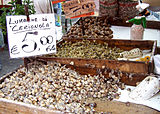
Land and freshwater gastropods - Helix pomatia
- Helix aspersa
- Helix aperta
- Cepaea nemoralis
- Otala lactea
- Escargot
Free-swimming marine bivalves - Scallop
- Queen scallop
- Pecten maximus
- Pecten jacobaeus
- Argopecten irradians
- Placopecten magellanicus
Infaunal bivalves - Clam
- Mercenaria mercenaria
- Austrovenus stutchburyi
- Saxidomus nutalli
- Arctica islandica
- Cockle
- Geoduck
- Spisula solidissima
- Paphies ventricosa
- Paphies australis
- Tuatua
- Ruditapes largillierti
- Grooved carpet shell
Sessile bivalves Freshwater bivalves Cephalopods Techniques Jewellery Forms Anklet · Belt buckle · Belly chain · Bindi · Bracelet · Brooch · Chatelaine · Collar pin · Crown · Cufflink · Earring · Lapel pin · Necklace · Pendant · Ring · Tiara · Tie clip · Toe ring · Watch (pocket)Making PeopleProcessesCasting (centrifugal, lost-wax, vacuum) · Enameling · Engraving · Filigree · Metal clay · Plating · Polishing · Repoussé and chasing · Soldering · Stonesetting · Wire wrappingToolsMaterials Precious metal alloysBritannia silver · Colored gold · Crown gold · Electrum · Platinum sterling · Shakudo · Shibuichi · Sterling silver · TumbagaMineral gemstonesAventurine · Agate · Alexandrite · Amethyst · Aquamarine · Carnelian · Citrine · Diamond · Diopside · Emerald · Garnet · Jade · Jasper · Lapis lazuli · Larimar · Malachite · Marcasite · Moonstone · Obsidian · Onyx · Opal · Peridot · Quartz · Ruby · Sapphire · Sodalite · Sunstone · Tanzanite · Tiger's eye · Topaz · Tourmaline · TurquoiseOrganic gemstonesTerms Categories:- Pearls
- Bivalves
- Gastropods
- Gemstones
- Jewellery components
- Mollusc products
- Molluscs
-
Wikimedia Foundation. 2010.

